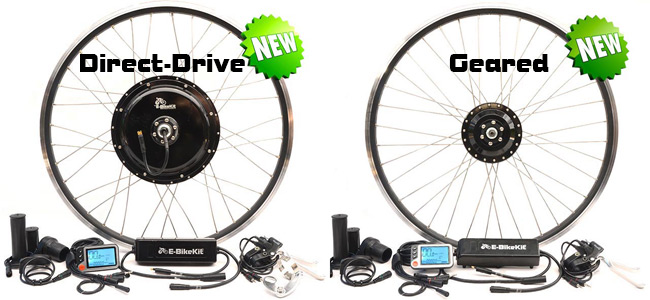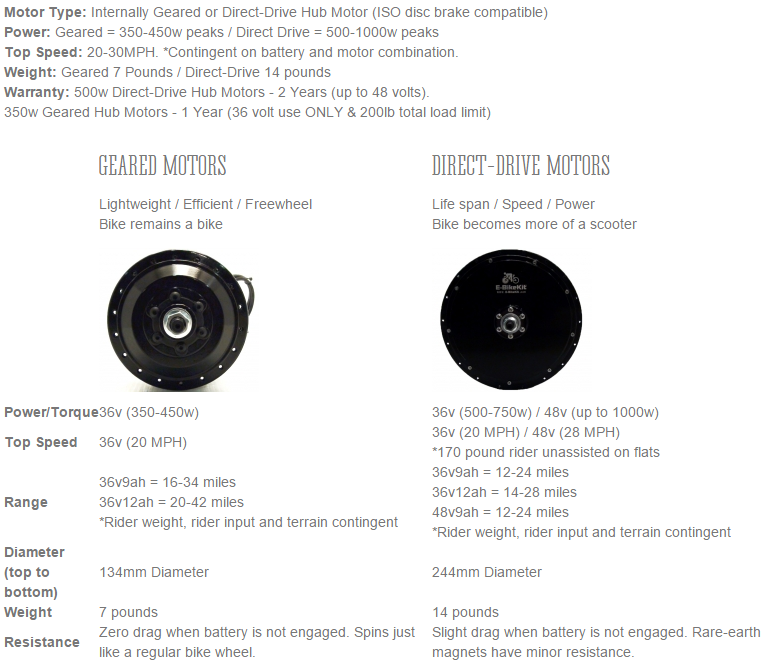A torque sensor can double the range of a pedalec through human power, the bike will feel like a bicycle, it will make you work but you will have bionic powers, the engine will take you up any hills, you will go faster and much longer distances. A throttle makes an ebike feel more like a motorcycle than a bicycle, but it is the quickest path to laziness there is. The torque sensor is a ‘an electronic throttle’ that determines how much juice to feed the motor based on how hard the rider is pedaling.
Throttle vs. Pedal Assist / Pedelec: In some UE countries the throttle electric bike is not allowed; only pedal assist. Different types of throttles: half grip twist throttle, thumb throttle, push button throttle, .. With pedal assist mode you can focus purely on your pedaling and you don’t have to hold the throttle in a certain position, it has a more intuitive feel. Some e-bikes come equipped with both the throttle and the pedal assist modes.

One horsepower is 746 Watts ie around 36V x 21A. If you take a given motor and begin raising the volts, the motor will spin faster and you will get extra power. If you begin raising the max amps, the acceleration will get faster, but you can overheat and burn the engine/controller. electricbike.com/12-kit-power-levels-360w-to-8000w


 Brushless planetary geared hub engines can provide the same torque as a motor twice more powerful and have the same range with a battery twice as small! If keeping your bike relatively lightweight is appealing and if stealthiness, freewheeling and increased range trump longevity, then a geared motor is likely your best option. If you’re expecting to rely more heavily on the motor (and looking to haul more weight), craving a higher top speed (20+ mph), solid long-lasting value, and a quiet motor, then a direct-drive may be best for you.
Brushless planetary geared hub engines can provide the same torque as a motor twice more powerful and have the same range with a battery twice as small! If keeping your bike relatively lightweight is appealing and if stealthiness, freewheeling and increased range trump longevity, then a geared motor is likely your best option. If you’re expecting to rely more heavily on the motor (and looking to haul more weight), craving a higher top speed (20+ mph), solid long-lasting value, and a quiet motor, then a direct-drive may be best for you.
Hub motors are unsprung weight in the wheel. Direct-Drive hub motors have drag when unpowered, making the bike feel sluggish to pedal.
The power of the electric bike motor can be a 100% indication how much energy the motor draws from the battery, but may be 60% indication on how powerful is the e-bike itself. The most important feature for electric bikes is the motor torque, since you carry a restricted amount of energy in your batteries, for optimized e-bike motor efficiency, the motor should have maximum possible torque with the minimum possible power. There are two independent ways to increase the motor efficiency: by using strong rare earth magnets or by increasing its speed and convert the speed into torque with built in torque converter. The first way, using strong rare earth magnets, is used in 90% of the hub motors. The second way was first used by the Hainzman motors. Because hub motor torque converters use planetary gears, which are highly efficient, the increase of the torque achieved by this method is tens of times bigger than the losses they introduce. The integrated gearing inside the motor allows a high torque initial start because the motor starts at its efficient high speed range immediately after the bike throttle is cranked. The integrated gearing also allows the motor to work more efficiently uphill when the speed of the bike is low; the hub motor has conserved its high speed momentum due to its torque converter. Another advantage of the torque converter is that it allows the size and the weight of the regular hub motor to reduced and increases the torque immensely or the same power consumption.
The other feature of the electric motor that we are continuously asked is if the motor recharges the battery, i.e., ‘does it regenerate?’ This regeneration as a power supply for battery recharging is not very efficient and cannot be relied on for recharging the battery, it has value more for electric braking. The regeneration efficiency of an electric bike is 20-40% which means that to fully recharge a discharged battery, one would have to go downhill 3 or 4 times longer than it would take to recharging a battery using a plugged-in charger. This means that the rider would have to go continuously downhill for 15 – 20 hrs for a full battery recharge. More realistically, if the route your ride your bike on has 20% downhill riding, you will generate enough electricity for 3.3% of the whole battery capacity. Geared motors can not be used for regenerative braking. Considering the fact however that regenerative braking for the e-bikes is mainly used for braking rather than battery recharge because of its low efficiency, the power you will save from the geared motor is much more than the power you gain from regeneration.

 Direct Drive v’s Geared Hub Motors
Direct Drive v’s Geared Hub Motors
Direct Drive Pros: Simple, no moving parts, Strong, they tend to last longer, Should be no maintenance, Can be used for regenerative braking
Direct Drive Cons: Heavier (in some cases about one and a half times the weight), Larger, Give some resistance to rolling
Geared Hub Motor Pro’s: Lighter, More efficient, Smaller, freewheel with little resistance
Geared Hub Motors Cons: Cogs can wear out and need replacing eventually, Can’t be used for regenerative braking, More complex, more to break
DD Hub Motors: Chrystalyte, Nine Continent, Bionix, Golden Motor, Cromotor
Geared Hub Motors: eZee, BMC, MAC, Mini-Geared, Bafang, Cute, Hill Topper

nominal power 250w, peak power 500w, torque 60-75Nm, weight 4.5kg www.mpfdrive.com/en/technology
Mid drive motors powers through the drivetrain of the bike which enables the motor to help with long & steep climbs and power up to high speeds on flat roads.
Mid Drive Motors: Bosch, Bafang, MPFdrive, ..
Pros
- Mid drive systems are known for being able to climb long steep hills because they can leverage the lower gears of the bike and keep their rpm’s in an efficient range without getting “bogged down” like a hub motor. This is a good feature if you ride in areas that have consistently long and steep climbs.
- These motors can also leverage the higher gears of the drivetrain to cruise along at high speeds on the flat or inclined roads.
- Since the motor is at the cranks of the bike it provides for a low and centered weight distribution. If the battery is mounted in the center of the bike that further adds to great weight distribution which is good for the handling of the bike as well as making it easier to lift onto a car rack or carry up stairs.
- Removing the front or rear wheel is easy because there are no motor wires or hardware to remove (compared to hub motors). The bike can use almost any wheel type along with quick releases front and rear.
- Most mid drive systems use a chain, cogs, and derailleur drivetrain. Some systems are compatible with internally geared hubs and belt drives. The E2 Drives combines the mid drive motor with a “gearbox” at the cranks.
- There is the ability for a mid drive system to use a throttle and/or cadence or torque sensor pedal assist. Some mid drives are pretty sophisticated with sensors that measure the pedal power, wheels speed, and crank speed to provide assist that blends with the riders power to create a very intuitive ride feel. There are also sensors that will reduce power when the system senses that the rider is going to shift gears to make the shift smoother. In addition there are some mid drives that are integrating with electronic shifting systems.
Cons
- Since the power is being transferred through the drivetrain of the bike there can be more wear applied to the drivetrain components (chain, cogs, derailleur, etc.). The higher power systems will add significantly more wear and those components may need to be replaced on a more frequent basis.
- To keep the mid drive motor operating efficiently you need to be shifting the gears properly for climbing hills or cruising along the flats. If you are used to shifting the gears properly on a conventional bike then this is nothing new.
- Some mid drive systems can sense when you are going to shift the gears and they will reduce the power for a smoother shift. There are some systems that don’t have these sensors and that can lead to abrupt shifts when the motor is applying full power.
- A majority of mid drives have a single chainring which limits the gear range to a rear cogset or to the gear range of an internally geared hub. For most riding conditions this is okay because the motor makes up for the gear range that is missing and the gear range of a rear cogset or IGH is pretty wide these days.
- Most of the popular mid drives systems are only available on complete e-bikes with specific frame mounts. There are not many retro-fit mid drive kits to choose from right now but it seems that there may be more on the horizon.

One thought on “Max.Range – torque sensor & geared drive – pedalec”